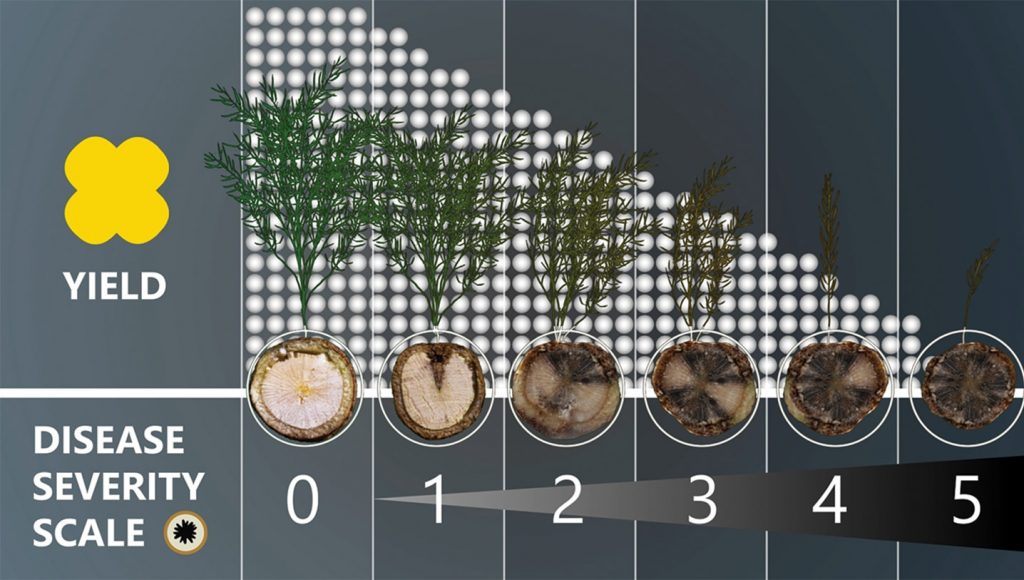The science behind blackleg resistance rotation
KEY RESULT:
SaskCanola administered Growing Forward 2-funded blackleg research projects that concluded over the past year or so. Results from these studies make it possible for farmers to test for the predominant blackleg races in a field and use this information to make strategic decisions for the deployment of varieties. This will reduce blackleg severity and hopefully increase the longevity of genetic resistance.
PROJECT TITLE, PRINCIPAL INVESTIGATOR:
For full names of the studies, please read “Canola disease management tools for the Prairies – Blackleg and Sclerotinia” at saskcanola.com/research
FUNDING:
Growing Forward 2
Rapid field diagnostics test for blackleg disease
Hossein Borhan with Agriculture and Agri-Food Canada (AAFC) Saskatoon led the study to develop a rapid DNA test to identify blackleg races present on canola stubble. The polymerase chain reaction (PCR) biomarkers, which is a common method for DNA analysis, were shared with public and private pathology labs across Western Canada. Four labs now have the markers for commercial evaluation. When growers detect significant amounts of blackleg in their field they may now send stubble samples to pathology labs for genetic testing. The pathology lab will then provide the grower with information on the specific races of blackleg in their field. This will enable canola growers to make informed decisions about choosing the appropriate blackleg resistance in their canola variety that best matches the profile of the blackleg strain in the field. This is an important tool for managing blackleg in the field and addresses a concern of a major trading partner.
Identification of new sources and genes for blackleg resistance
Hossein Borhan at AAFC Saskatoon and Genyi Li and Dilantha Fernando at the University of Manitoba led projects to identify new genes for blackleg resistance. Several novel blackleg resistance genes were identified, which can be used by seed companies to improve their genetic base. Preliminary mapping conducted on one of these lines support presence of a novel broad spectrum resistance (R) gene against blackleg disease. A total of 58 lines with quantitative resistance to blackleg disease were identified and presence of quantitative resistance was confirmed. While not major gene resistance, quantitative is a durable form of resistance and protects canola against the blackleg infection.
Development of blackleg resistance gene labels
Dilantha Fernando at the University of Manitoba, Gary Peng with AAFC Saskatoon and Ralph Lange with Innotech in Alberta led projects to enhance our understanding of the durability of some R genes used within commercial cultivars. This helped form the foundation for major gene resistance labels now used in blackleg resistance identification. Producers can now choose varieties with R genes that are durable to the specific blackleg races identified through the new commercial stubble tests. This will play a significant role in reducing blackleg in the field in Canada, and assist breeders in advancing cultivar resistance and durability.
Development of a blackleg yield loss model
To demonstrate why these blackleg management steps are so important for farmers, Stephen Strelkov with the University of Alberta led a project to study the relationship between blackleg severity and yield loss. Producers can now estimate the amount of yield loss from blackleg in their canola fields. To use the blackleg yield loss model, producers need to complete a pre-harvest survey of 50-100 plants that well present the field. Clip these plants near the base of the root tissue to determine the incidence and severity of blackleg infection. Severity of blackleg is rated on a 0-5 scale, with 0 being a healthy clean plant to 5 showing internal blackening across the entire cross-section of the stem. For every unit of increase in blackleg severity (from a 1 rating to a 2 rating, for example), roughly 20 per cent yield loss can be expected per plant. Take the field yield average, the average BL severity and the percentage of plants infected (incidence) to determine the amount of yield lost.

Combine the results for better blackleg management
When these research findings are used together, they help to provide a full IPM toolkit; providing producers with more options to manage this disease.
The new resistant sources will take some time before being found in commercial varieties but will provide diversity in sources being deployed. The blackleg race ID test provides more information for making variety decisions. This is where the new blackleg resistance labels come in handy and allows the industry to see what sources of genetics are being deployed. Knowing this information will help the industry better steward these resistance genes and hopefully minimize the risk of overcoming the genes. The yield loss model has been a first in Canada, which lets us see the economic impact blackleg has to canola production. Putting a dollar value on the damage helps to promote all the other tools we have for managing this disease.
For more on blackleg and disease management, go to blackleg.ca.





